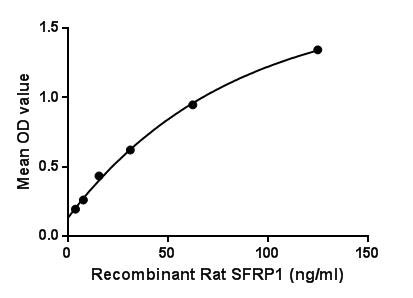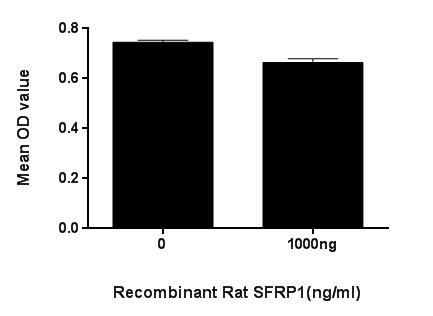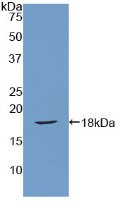
Details
ACTIVITY TEST
Buffer Formulation 20mM Tris, 150mM NaCl, pH8.0, containing 1mM EDTA, 1mM DTT, 0.01% SKL, 5% Trehalose and Proclin300. Traits Freeze-dried powder Purity > 95% Isoelectric Point 9.1 Applications Cell culture; Activity Assays.

Secreted frizzled-related protein 1, also known as SFRP1 is a member of the SFRP family that contains a cysteine-rich domain homologous to the putative Wnt-binding site of Frizzled proteins. It acts as a biphasic modulator of Wnt signaling, counteracting Wnt-induced effects at high concentrations and promoting them at lower concentrations. As a tumor suppressor, SFRP1 expression markedly inhibited tumor cell growth in culture, soft agar and xenografts in athymic nude mice. Besides, Wingless Type MMTV Integration Site Family, Member 2 (WNT2) has been identified as an interactor of SFRP1, thus a binding ELISA assay was conducted to detect the interaction of recombinant rat SFRP1 and recombinant rat WNT2. Briefly, SFRP1 were diluted serially in PBS, with 0.01% BSA (pH 7.4). Duplicate samples of 100μL were then transferred to WNT2-coated microtiter wells and incubated for 2h at 37℃. Wells were washed with PBST and incubated for 1h with anti-SFRP1 pAb, then aspirated and washed 3 times. After incubation with HRP labelled secondary antibody, wells were aspirated and washed 3 times. With the addition of substrate solution, wells were incubated 15-25 minutes at 37℃. Finally, add 50µL stop solution to the wells and read at 450nm immediately. The binding activity of SFRP1 and WNT2 was shown in Figure 1, and this effect was in a dose dependent manner.
Figure. The binding activity of SFRP1 with WNT2.
To measuered the ability of SFRP1 on tumor suppression, liver cancer HepG2 cells were seeded into triplicate wells of 96-well plates at a density of 5,000 cells/well and allowed to attach, replaced with serum-free overnight, then the medium was replaced with 2% serum standard DMEM prior to the addition of various concentrations of recombinant rat SFRP1. After incubated for 96h, cells were observed by inverted microscope and cell proliferation was measured by Cell Counting Kit-8 (CCK-8). Briefly, 10µL of CCK-8 solution was added to each well of the plate, then the absorbance at 450nm was measured using a microplate reader after incubating the plate for 1-4 hours at 37℃. Suppression of HepG2 cells after incubation with SFRP1 for 96h observed by inverted microscope was shown in Figure 2. Cell viability was assessed by CCK-8 assay after incubation with recombinant SFRP1 for 96h. The result was shown in Figure 3. It was obvious that SFRP1 significantly decreased cell viability of HepG2 cells. (A) HepG2 cells cultured in DMEM, stimulated with 1000ng/mL SFRP1 for 96h; (B) Unstimulated HepG2 cells cultured in DMEM for 96h.
Figure. Cell suppresstion of HepG2 cells after stimulated with SFRP1.
Figure. Cell suppresstion of HepG2 cells after stimulated with SFRP1.
USAGE
Reconstitute in 20mM Tris, 150mM NaCl (pH8.0) to a concentration of 0.1-1.0 mg/mL. Do not vortex.
STORAGE
Avoid repeated freeze/thaw cycles. Store at 2-8°C for one month. Aliquot and store at -80°C for 12 months.
STABILITY
The thermal stability is described by the loss rate. The loss rate was determined by accelerated thermal degradation test, that is, incubate the protein at 37°C for 48h, and no obvious degradation and precipitation were observed. The loss rate is less than 5% within the expiration date under appropriate storage condition.
Image

Figure. SDS-PAGE

Figure. Western Blot
Partial purchase records(bought amounts latest0)
User Comment(Total0User Comment Num)
- No comment


 +86 571 56623320
+86 571 56623320




